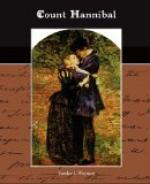CHAPTER III. THE HOUSE NEXT THE GOLDEN MAID.
We have it on record that before the Comte de la Rochefoucauld left the Louvre that night he received the strongest hints of the peril which threatened him; and at least one written warning was handed to him by a stranger in black, and by him in turn was communicated to the King of Navarre. We are told further that when he took his final leave, about the hour of eleven, he found the courtyard brilliantly lighted, and the three companies of guards—Swiss, Scotch, and French—drawn up in ranked array from the door of the great hall to the gate which opened on the street. But, the chronicler adds, neither this precaution, sinister as it appeared to some of his suite, nor the grave farewell which Rambouillet, from his post at the gate, took of one of his gentlemen, shook that chivalrous soul or sapped its generous confidence.
M. de Tignonville was young and less versed in danger than the Governor of Rochelle; with him, had he seen so much, it might have been different. But he left the Louvre an hour earlier—at a time when the precincts of the palace, gloomy-seeming to us in the light cast by coming events, wore their wonted aspect. His thoughts, moreover, as he crossed the courtyard, were otherwise employed. So much so, indeed, that though he signed to his two servants to follow him, he seemed barely conscious what he was doing; nor did he shake off his reverie until he reached the corner of the Rue Baillet. Here the voices of the Swiss who stood on guard opposite Coligny’s lodgings, at the end of the Rue Bethizy, could be plainly heard. They had kindled a fire in an iron basket set in the middle of the road, and knots of them were visible in the distance, moving to and fro about their piled arms.
Tignonville paused before he came within the radius of the firelight, and, turning, bade his servants take their way home. “I shall follow, but I have business first,” he added curtly.
The elder of the two demurred. “The streets are not too safe,” he said. “In two hours or less, my lord, it will be midnight. And then—”
“Go, booby; do you think I am a child?” his master retorted angrily. “I’ve my sword and can use it. I shall not be long. And do you hear, men, keep a still tongue, will you?”
The men, country fellows, obeyed reluctantly, and with a full intention of sneaking after him the moment he had turned his back. But he suspected them of this, and stood where he was until they had passed the fire, and could no longer detect his movements. Then he plunged quickly into the Rue Baillet, gained through it the Rue du Roule, and traversing that also, turned to the right into the Rue Ferronerie, the main thoroughfare, east and west, of Paris. Here he halted in front of the long, dark outer wall of the Cemetery of the Innocents, in which, across the tombstones and among the sepulchres of dead Paris, the living Paris of that day, bought and sold, walked, gossiped, and made love.




